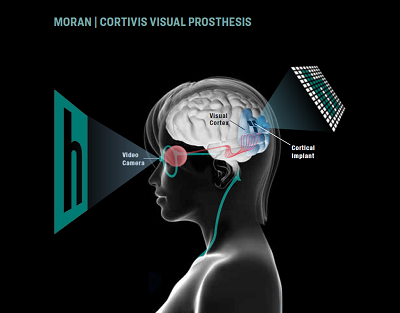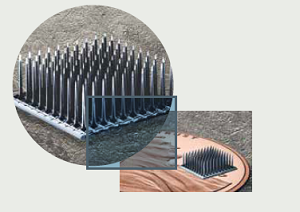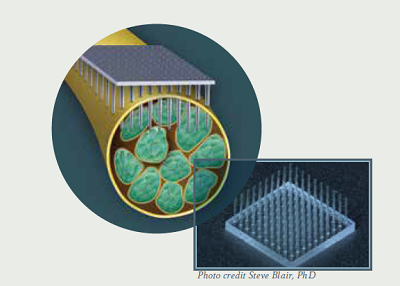Three decades ago, University of Utah bioengineer Richard A. Normann, PhD, had a radical new idea he hoped might create artificial sight for people who had lost their vision due to disease. If the eyes couldn’t function anymore, why not let the brain do all the work?
His inspiration resulted in the creation of the Utah Electrode Array (UEA), a tiny device implanted into the brain that may soon bring artificial vision one step closer to reality.
Now, one of his collaborators, University of Utah neuroscientist Alessandra Angelucci, MD, PhD, is building on Normann’s groundbreaking research to develop a next generation array. It’s a technological leap akin to the shift from flip phone to iPhone, and the latest advance in the quest to understand the brain’s remarkable ability to create vision.

Finding the ‘Right Kind of Tool’
As a child, Normann was a tinkerer. His father owned and installed pinball machines, and Normann’s own creations quickly emerged from their discarded parts. In college, his aptitude for engineering was clear, but Normann began to develop an interest in the inner workings of the body and took up physiology.
He combined the two disciplines as a University of Utah professor of biomedical engineering and ophthalmology and visual sciences, and in the 1980s decided to investigate how to restore sight to those who had lost it to disease.
"People had been dreaming about restoring sight to the blind for quite a while, but they didn’t have the right kind of tool," Normann said. "So we just decided to have a dinner party, inviting scientists and engineers from our campus and around the country. We talked about what was keeping us from actually making blind people see. After that night, it became clear to us what was really needed."
Normann’s dinner party epiphany resulted in the creation of the UEA. Much smaller than a penny, the device uses a series of silicon microelectrodes implanted into the brain to record and replay the electrical activity of neurons. It’s this communication between neurons that creates vision, and countless other body functions.

Before the UEA, researchers had only tracked the electrical activity of just a few neurons in one location of the brain using a single electrode positioned on the organ’s surface or implanted in the brain. Using multiple electrodes has been a technological breakthrough, and successful testing of the device has been a bit like something straight out of a science fiction novel.
Normann and a colleague—University of Utah Bioengineering Associate Professor Gregory Clark, PhD— decided the safest and most practical way to initially evaluate the UEA would be with the help of forearm amputees. In these experiments, people were able to move a motorized prosthetic hand with their thoughts and experience a sense of touch. How did it work? A person thought about moving their hand. The UEA, implanted into the nerves of the arm, recorded those neural signals and sent them to the prosthetic. The success of those and many other experiments led to the commercial licensing of the UEA, used by scientists around the world.

People had been dreaming about restoring sight to the blind for quite a while, but they didn’t have the right kind of tool.
Richard A. Normann, PhD
Now, Normann hopes to realize his dream to restore useful vision with the UEA by bypassing the eyes and going straight to the brain. The idea: a person could wear glasses with a video camera attached to record real-world images. The UEA, receiving input from the video camera through an attached wire, could translate the images into a form of artificial vision the brain would recognize as sight.
Although that vision would be pixelated, it should be just enough to allow a blind person to navigate through a doorway or around objects on the street without assistance, substantially improving their quality of life.
After decades of research and with an impressive list of collaborators, Normann plans to begin implanting the UEA, called the Moran/Cortivis Visual Prosthesis, in vision patients in Spain. "The name ‘Cortivis’ reflects the relationship between Moran and our Spanish collaborators," said Normann. If successful, the testing should produce a blueprint for creating artificial sight.
Building on a Breakthrough
Angelucci is among Normann’s collaborators, sharing his hope for restoring sight. But committing her to the project took some coaxing.
"I resisted," said Angelucci, a neuro-scientist who has devoted the past two decades of her research to understanding how the brain functions. "I thought if we didn’t know exactly how neurons in the visual cortex work, how can we know how to fix vision?"
Normann encouraged her to think big and be willing to take risks. The success of the UEA in controlling forearm prosthetics changed her mind.
"Today, we totally complement each other: the UEA is a great tool to understand how the brain works," said Angelucci, adding that she uses Normann’s technology "to ask neuroscience questions, building on his innovation."

I thought if we didn’t know exactly how neurons in the visual cortex work, how can we know how to fix vision?
Alessandra Angelucci, MD, PhD
Angelucci, part of the National Institute of Health's (NIH) initiative to map the human brain, is using the UEA as the basis for a next generation of neuron interfacing array, called the Utah Optrode Array (UOA). She’s collaborating with University of Utah Department of Electrical and Computer Engineering Professors Steve Blair, PhD, and Loren Rieth, PhD, on an NIH BRAIN Initiative grant to adapt the UEA to use with optogenetics. Optogenetics, which activates neurons using light rather than electricity, will allow her to overcome one of the limitations of the UEA.
"Any neuron near an electrode in a UEA implanted in the brain will get ‘turned on’ by electrical currents injected into the brain via the UEA electrode, regardless of the direction they are going," Angelucci explained. "But that’s not how the brain works. The brain gets activated in specific pathways depending on specific tasks."
With optogenetics, Angelucci can fine-tune which neurons are turned on to provide an unprecedented level of control that represents the next step in artificial vision research.
While the design of Angelucci and Normann’s devices are similar, the UOA uses 100 glass needles topped with lightemitting diodes (commonly known as LED lights) instead of metal electrodes.
Development of the UOA is still in the early phases. But it’s a step in the right direction to answer questions about how vision works.
"The more we understand how neurons in the brain communicate, the more we’ll be able to repeat those patterns to re-create visual function," said Angelucci.
Normann has been an inspiration, she continued, "and now, I’m directly involved in restoring vision."